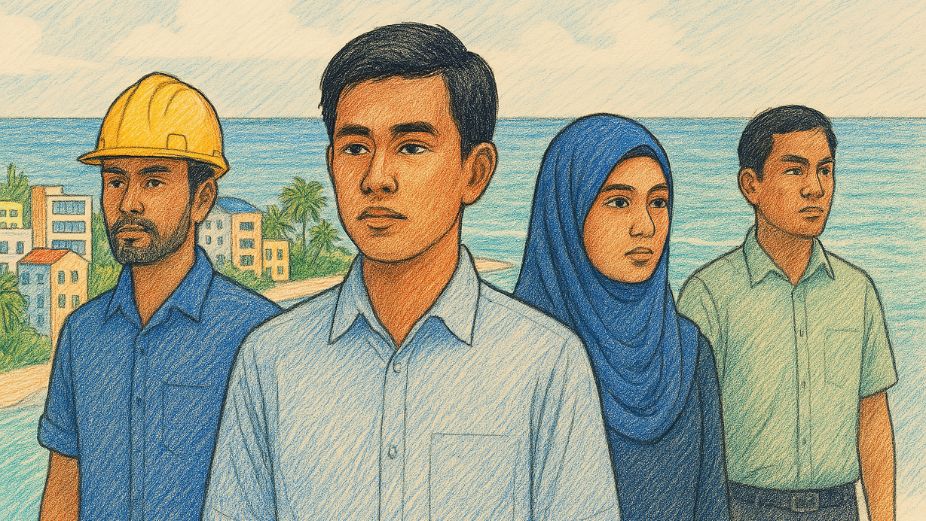
The Maldives has been exporting its brightest minds and importing its workforce for decades. While resorts thrive and the world marvels at its beauty, a silent crisis continues to erode the country’s future from within: the chronic underdevelopment of its own human capital. This is not a new problem — but it is one that can no longer be ignored.
A Labour Market Out of Balance
The Maldivian workforce is characterised by a high dependence on expatriate labour and persistent mismatches between education and employment. According to the Maldives Bureau of Statistics’ 2022 Census, the working-age population (aged 15–64) stood at approximately 390,592. Of those employed, around 29% were foreign nationals, based on the Bureau’s Employment Analysis 2024 report. This means that nearly one in every three workers in the Maldives is an expatriate. The concentration is even higher in the tourism sector: in resort islands, expatriates made up 59% of the workforce as of 2022, according to the Bureau’s Employment in Resorts 2022 report. These figures highlight the structural reliance on foreign labour, particularly in sectors where local participation remains limited.
This reliance is expensive. In 2023, remittances sent abroad by foreign workers reached an estimated USD 599 million, a significant outflow for a small economy. But beyond the financial cost is the underlying question: why aren’t Maldivians filling these roles?
Employers regularly cite a shortage of relevant skills among local applicants, especially in specialised or technical fields. There is also reluctance among many Maldivians to take on low-paid or so-called “low-status” jobs. The International Labour Organization has pointed to this mismatch – between the training Maldivians receive and the needs of the labour market – as a key factor contributing to high unemployment among locals. At the same time, some employers continue to favour foreign hires due to perceptions around work experience or attitude.
Women, too, are underrepresented. Although girls and women achieve comparable levels of education, only 46% of working-age women participate in the labour force, compared with 77% of men. Cultural expectations, lack of childcare, and inflexible working conditions limit their participation. Yet this represents a vast pool of untapped potential. Flexible working hours, support for childcare, and thoughtful policy reforms could bring more women into the economy and ease pressure on labour shortages.
The Scale and Cost of Brain Drain
In the Maldives, brain drain remains a deep concern. Many Maldivians who seek higher education abroad often choose not to return. As one Maldives Financial Review commentary put it, the returns on investment in education are often better abroad. The outcome is clear: a significant share of the country’s most educated citizens settle overseas.
Though the Maldivian diaspora remains small in numbers, it includes a disproportionate number of university graduates and professionals. The true figure today is likely higher, particularly as more students study abroad. Until recently, the government had no system for tracking student return rates or monitoring talent emigration. A 2022 census survey sought to address this, signalling a shift in policy attention toward brain drain.
The Maldives has ranked above the global average on the Human Flight and Brain Drain Index for much of the past two decades, with an average score of 6.16 (out of 10) between 2007 and 2024, compared to a global average of 4.98 over the same period, according to data from Fund for Peace, an American non-profit, non-governmental research and educational institution. In 2023, the Maldives’ score fell slightly to 5.2, yet the underlying challenge of retaining skilled talent persists.
The impacts are most visible in critical sectors. As of 2020, around 72% of health workers in the Maldives were expatriates, including two-thirds of doctors. Similar patterns are seen in education and IT. These shortages not only reflect the limited output of local training institutions but also highlight how the lack of career opportunities at home drives talent abroad. This creates a vicious cycle: the more skilled professionals leave, the less capacity remains to train the next generation.
Some Maldivians abroad contribute through remittances or global networks, but for a country with such a small population, the permanent loss of each graduate carries considerable weight. Turning brain drain into “brain gain” will require stronger incentives for return – including housing support, job placement programmes, and greater recognition of international qualifications – as well as efforts to engage the diaspora in national development remotely.
Education: Strong Access, Uneven Outcomes
Education is the foundation of human capital, and here the Maldives has made substantial strides. Literacy rates are high, and public schooling is free through year 12. A child in the Maldives can expect to receive 12.4 years of education by age 18, on par with many upper-middle-income countries. However, quality remains a significant concern.
According to the World Bank’s 2024 Human Capital Review, the effective number of learning years is just 8.1 – a loss of over four years due to poor quality. Students may be enrolled in school, but their education is often overly reliant on rote memorisation rather than critical thinking or applied skills.
The bottleneck in secondary education is particularly concerning. Many students fail their O-Level exams, cutting off access to A-Levels and limiting career prospects. Those who drop out at 16 are left with few opportunities and limited skills. Technical and Vocational Education and Training (TVET) is critical here but has historically been small and disconnected from labour demand.
That is slowly beginning to change. TVET programmes have expanded in recent years, with resort groups and private sector employers beginning to invest in tailored training. For example, courses in diving and construction in the atolls are helping equip youth with locally relevant skills. However, employers continue to report gaps in both technical ability and soft skills such as communication, punctuality, and teamwork.
Higher education, too, is expanding. Since the 2000s, local institutions like the Maldives National University (MNU) and Villa College have opened new pathways. Tertiary enrolment rose by 62% from 2019 to 2022, thanks in part to the government’s First Degree Scheme, introduced during President Solih’s administration, which offers state-funded degrees. Around 18,900 students enrolled under this scheme over four years, and 1,693 scholarships were awarded during that period.
Yet concerns about alignment persist. The most popular degrees remain in fields like business, teaching, and law, while enrolment in technical and scientific subjects – including engineering and environmental science – remains limited. Until recently, the country lacked a local medical school altogether. As a result, many students pursue these degrees abroad and a portion of them may not return. The lack of bonding requirements or structured return pathways for scholarship recipients has compounded this issue.
Some experts have suggested inviting foreign universities to establish local campuses or launching joint degree programmes, so that students can access high-quality education without leaving the country. Until then, gaps in academic quality, research capacity, and practical exposure will likely remain barriers to building a strong, self-reliant workforce.
Lessons from Elsewhere
Singapore’s experience offers a useful model. With a similarly small domestic market and no natural resources, Singapore bet early on its people. By aligning education planning with economic policy, investing in teacher training, and creating institutions that support ongoing skills development, the country transformed itself from a low-income port to one of the world’s most competitive economies.
Initiatives like SkillsFuture, which provides adults with credits to continue learning throughout their careers, have made Singapore’s workforce flexible and future-ready. While differences between Singapore and the Maldives are significant, the principle holds: human capital development must be a continuous process, supported by strong institutions, policy consistency, and deep collaboration with employers.
Building a Human Capital Strategy
For the Maldives to compete globally and build a diversified economy, it must double down on investing in its people. Improving the quality of education, especially at the secondary and vocational levels, is vital. Curriculum reform, teacher training, and stronger engagement with industry can help bridge the skills mismatch.
Addressing brain drain requires more than pay rises – it demands an ecosystem where professionals see long-term opportunities for growth. This includes supporting entrepreneurship, research, and digital innovation, and ensuring young Maldivians can build meaningful careers without leaving their country. For those who do go abroad, return should be a realistic and attractive option, backed by supportive policies and active outreach.
Good governance, long-term planning, and cross-sector coordination will be essential. A national human capital strategy – built on reliable data and aligned across ministries – can bring focus to the effort. Shifting investment from infrastructure to education and people may be politically delicate, but it is critical for resilience and sustainability.
The Maldives may be small, but its ambitions need not be. By committing to human capital, the country can shape a future where opportunity, innovation, and leadership are home-grown – and where prosperity is shared not just by visitors, but by the citizens who call these islands home.












